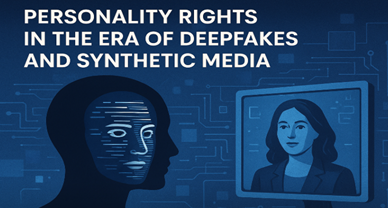Copyright Of Cinematograph Films: Indian Scenario
Introduction
The Indian Copyright Act of 1957 protects and recognizes cinematograph films as a form of creative work. Cinematograph films are a type of motion picture created using a device called a cinematograph, which projects a series of images in quick succession to give the illusion of motion on a screen. According to Section 2(d)(v) of the Copyright Act, the producer of a cinematograph film is considered the work’s creator.[1]
The creation of a movie involves collaboration between multiple individuals including the director, actors, composer of the soundtrack, and screenwriter, but under copyright law, only the producer is considered the film’s sole creator and owner. This preference for producers in copyright law has recently been questioned. Disputes over the rights to the script and music used in the movie have arisen between producers and other contributors such as scriptwriters and musical composers.[2]
Conflicts of copyright in cinematograph films
The script of a movie is considered a literary work and has its separate copyright, which is one of several compositions in the movie that are protected by copyright. Music compositions are also given their unique copyright protection. Recently, there have been instances of disputes between film producers and scriptwriters or musical composers over rights such as remakes, dubbing rights, etc.[3] Another issue is that film directors are not recognized by copyright laws, leading some to argue that both producers and directors should have co-authorship.[4] The Copyright (Amendment) Act of 2012 was enacted to establish a fair and rational system for copyright administration, and revenue sharing, and to protect the rights of those involved in audio and video recordings.[5] This act reinforced the existing stance that the producer is the author, as opposed to the Copyright (Amendment) Bill of 2010 which would have recognized the principal director as a co-author of the composition.[6]
[Image Sources : Shutterstock]
Conflict of producers of cinematograph films with other stakeholders in India
In the IPRS v. Eastern India Motion Pictures Association case, the Indian Performing Right Society (IPRS) established its tariff system in 1977 for licensing musical works and lyrics for public performances (known as the IPRS case). The producers of the movie in question disputed the system, claiming that they were the true creators of the work and that the music and lyrics used in the film were not protected by copyright or public performance rights.[7] They argued that since they paid for these elements to be used in their movie, they had legitimate ownership of the final product. On the other hand, the authors of the works claimed that while the producers would own the rights to synchronize the music with the visuals, the authors would retain the rights to public performances. The Copyright Board initially sided with the authors, but this decision was later overturned by the court and the producers’ rights were confirmed by the Supreme Court in an appeal.
Inadequate understanding of directors’ rights in Cinematograph films
According to some experts in intellectual property rights, the 2012 modifications to the Copyright Act were a disappointment due to the absence of sections 17(f) and 17(g) of the proposed copyright (Amendment) Bill, 2010.[8] These provisions recognized the rights of directors. The standing committee, however, argued that this would harm the film industry, claiming that the absence of recognition for lyricists and composers would hinder its development, but recognizing the rights of directors would have a negative impact. The lack of clear reasoning only discrimination against directors more apparent. The director plays a crucial role in the film, shaping its overall vision and yet they are not acknowledged under the Copyright Act, which is a bias against their contribution.[9] The producer, who assumes legal and financial responsibility for the film, may be granted authorship title, even if they didn’t create the work, but the director’s role as a key creator cannot be ignored. There is a conflict between scriptwriters and producers.[10]
CONCLUSION and SUGGESTIONS
It is important to highlight the current state of the copyright system in India, which appears to prioritize the interests of producers over those of directors, scriptwriters, composers, etc. The argument that producers should have ownership of the copyright because they bear the risk of making the movie is not convincing when compared to other industries such as publishing, where the publisher bears a similar risk but does not have authorship or ownership of the copyright under the law. This apparent favoritism towards producers is now being questioned. However, the creators of the original work, who play a crucial role in the creation of the film, are not given the same level of consideration. This is evident in the case of the primary director, who is not recognized under the law, and serves as a strong example of this imbalance.
Recently, an interesting case emerged in which a First Information Report (FIR) was filed against Yash Raj Films (YRF), a prominent production company in Mumbai, under sections 409, 34 of the Indian Penal Code, 1860, and section 63 of the Copyright Act. The FIR accused YRF of committing a criminal breach of trust (CBT) and violating the Copyright Act by misappropriating 100 crores in royalties that belonged to members of the Indian Performing Right Society (IPRS). The FIR accused YRF of using its dominant bargaining position to force musicians into signing contracts that deprived them of the royalties that were rightfully theirs.
As per section 18(1), the author, not the copyright holder, is entitled to receive royalties. It’s crucial to differentiate between author and owner in this context. Although the ownership of a work can be transferred by assigning the copyright, the author always remains the same and is not considered when referring to the owner of the work. Hence, even if YRF can establish that they are the rightful owners of the works they earn royalties from, they do not possess the author’s right to an equal portion of the royalties.
Otherwise, the objective of the amendment will not be realized. In the case of Ilayaraja v. Agi Music, the court made two rulings that severely restricted the rights of songwriters. Firstly, it stated that the 2012 changes did not mention that the composers would retain their ownership rights. The only assurance given was the payment of royalties to the creators and their descendants of musical works. Secondly, the court stated that while musical works are embodied in sound recordings in films, additional sound recordings cannot be made based on those same recordings. This interpretation further restricts the rights of composers in an industry that is already biased. The court disregarded the newly added proviso to section 17 of the Copyright Act in conjunction with section 13(4), which stated that the author’s original copyright guaranteed under section 13 of the Copyright Act would not be lost just because their work was included in a film. It appeared that the court only focused on the amendment of section 18 of the Copyright Act, which provided for royalty rights to the creators of works.
Regarding the rights of screenwriters with regards to producers, despite the controversial ruling in the Thiagarajan Kumaraja case that stated that dubbing is not considered a remake, and thus screenwriters still maintain their rights in such cases, the outcome of the Salim Khan case has not provided the same assurance to screenwriters. The court in the Salim Khan case determined that the script for the movie “Zanjeer” was a work created on commission, and thus accepted the producers’ argument over that of the screenwriter.
The court’s decision did not mention the exception in Section 17 which stated that the use of a work in a film would not affect the author’s rights under Section 13(4) of the Copyright Act. It will be intriguing to observe how this provision will be interpreted by the courts in the future. Will they decide that screenwriters are entitled to all rights related to remakes, including works created on commission, which is considered fair? Or like in the case of Ilayaraja regarding the rights of composers, will they only be granted royalty payments?
Author: Anupreet Kaur, A student at Narsee Monjee Institute of Management Studies, Navi Mumbai, in case of any queries please contact/write back to us at support@ipandlegalfilings.com or IP & Legal Filing.
REFERENCES
- https://copyright.gov.in/documents/copyrightrules1957.pdf
- https://www.wipo.int/copyright/en/faq_copyright.html
- https://ogc.harvard.edu/pages/copyright-and-fair-use
- https://fairuse.stanford.edu/overview/introduction/getting-permission/
- https://indiankanoon.org/doc/63302604/
- https://www.wto.org/english/tratop_e/trips_e/ta_docs_e/modules2_e.pdf
- https://www.scconline.com/blog/post/2022/08/31/whose-script-is-it-a-legal-perspective/
- https://spicyip.com/2022/07/old-is-no-longer-gold-do-copyright-in-films-songs-expire-with-the-60-year-limit.html
- https://corpbiz.io/learning/type-of-works-protected-by-copyright-in-india/
- https://www.bananaip.com/ip-news-center/indian-copyright-orders-and-judgments-2020/
- https://www.drishtiias.com/to-the-points/paper3/intellectual-property-rights
[1]https://www.indiacode.nic.in/show-data?actid=AC_CEN_11_61_00003_200016_1517807322629§ionId=2569§ionno=2&orderno=2
[2] Supra note 4 at s. 106A
[3] Marley C. Nelson, Moral Rights in the United States, available at: https://library.osu.edu/ site/copyright/2017/07/21/moral-rights-in-the-united-states/
[4] With respect to cinematographic works, the countries that protect the author rather than the author’s employer include Belgium, Denmark, Germany, France, and Italy. Refer, Anne Moebes, Copyright Protection of Audio-Visual Works in the European Community 15(2) Hastings Communication and Entertainment Law Journal 399-415 (1992).
[5] https://www.indiacode.nic.in/repealed-act/repealed_act_documents/A2012-27.pdf
[6]https://prsindia.org/billtrack/the-copyright-amendment-bill-2010#:~:text=The%20Bill%20allows%20for%20the,for%20use%20by%20such%20persons.
[7] https://www.bananaip.com/ip-news-center/indian-performing-rights-soceity-v/
[8] https://cis-india.org/a2k/blogs/analysis-copyright-amendment-bill-2012
[9] https://www.wipo.int/pressroom/en/stories/ip_and_film.html
[10] W. Cornish, D. Llewelyn and T. Aplin, Intellectual Property: Patents, Copyright, Trademarks and Allied Rights 471(Sweet and Maxwell, London, 2010).



